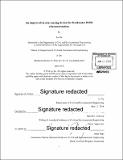An improved in situ sensing device for freshwater DOM characterization
Author(s)
Xu, Lu, M. Eng Massachusetts Institute of Technology
DownloadFull printable version (5.482Mb)
Other Contributors
Massachusetts Institute of Technology. Department of Civil and Environmental Engineering.
Advisor
Harold F. Hemond.
Terms of use
Metadata
Show full item recordAbstract
DOC characterization of freshwater is poorly understood at areas of harsh or difficult to access, especially areas like peatland rainforest. In order to figure out the level of DOC transport, an in situ instrument was previously designed to measure the DOC concentration at remote locations. However, the data collected by the instrument is not as meaningful as expected due to the complex environment, high DOC concentration and inner shielding. A new instrument is required to be designed to fulfil the objectives. Like the previous instrument, the new instrument still needs to measure the fluorescence and absorbance data to give an estimation of DOC concentration. There are three LEDs to provide fluorescence measurements, a wideband lamp to provide light for absorbance measurement and a spectrometer to record the resulting spectra. Unlike general in situ fluorometers, the orientation between the excitation source and detector is 90 degrees for the new optical configuration. The new designed optical configuration solves the problem of window obstruction and also successfully prevents the problem of misalignment caused by water turbulence. Furthermore, the instrument also solves the problem of long light path lengths with the new configuration. The instrument was tested to work well in the lab with a range of DOC concentration from 5 ppm to 60 ppm. The recorded data showed a strong positive relationship between fluorescence intensity and concentration of DOC.
Description
Thesis: M. Eng., Massachusetts Institute of Technology, Department of Civil and Environmental Engineering, 2016. Cataloged from PDF version of thesis. Includes bibliographical references (pages 27-28).
Date issued
2016Department
Massachusetts Institute of Technology. Department of Civil and Environmental EngineeringPublisher
Massachusetts Institute of Technology
Keywords
Civil and Environmental Engineering.